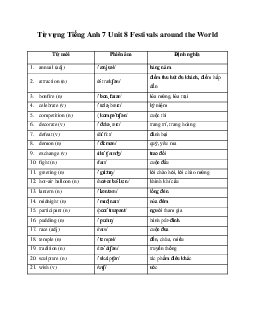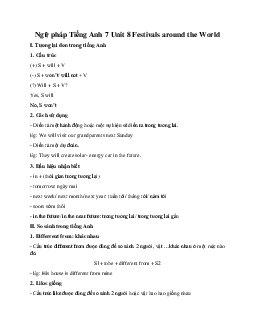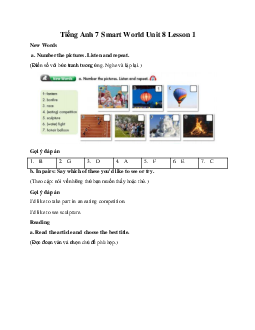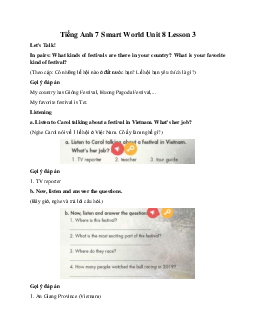






Preview text:
Tiếng Anh 7 Smart World Unit 8 Lesson 2 New Words
a. Fill in the blanks. Listen and repeat.
(Điền vào chỗ trống. Nghe và lặp lại. Gợi ý đáp án 1. celebrate 2. midnight 3. wish 4. tradition 5. greeting 6. exchange
Lời giải chi tiết
1. Some Asian countries, such as Vietnam and South Korea, celebrate Lunar New Year.
(Một số nước châu Á như Việt Nam, Hàn Quốc đón Tết Nguyên đán.)
2. The boy wanted to stay up until midnight to see the fireworks, but he fell asleep at 11:30 p.m.
(Cậu bé muốn thức đến nửa đêm để xem pháo hoa, nhưng cậu đã ngủ quên lúc 11:30 tối.)
3. I'm going to send him a card and wish him a happy birthday.
(Tôi sẽ gửi cho anh ấy một tấm thiệp và chúc anh ấy sinh nhật vui vẻ.)
4. Many European countries share the tradition of having a big family meal on Christmas Day.
(Nhiều nước châu Âu có truyền thống tổ chức một bữa ăn đại gia đình vào ngày lễ Giáng sinh.)
5. He welcomed me with a warm greeting and introduced me to his friends.
(Anh ấy chào đón tôi bằng một lời chào nồng nhiệt và giới thiệu tôi với bạn bè của anh ấy.)
6. We share the same birthday, so we often exchange gifts with each other. Last year, I
gave him a book and he gave me a board game.
(Chúng tôi có cùng ngày sinh nhật nên thường trao đổi quà cho nhau. Năm ngoái, tôi tặng
anh ấy một cuốn sách và anh ấy tặng tôi một trò chơi cờ bàn.)
b. In pairs: Talk about festivals and holidays in your country and the traditions to celebrate them.
(Theo cặp: Nói về lễ hội và kỳ nghỉ ở đất nước bạn và truyền thống kỷ niệm chúng.) Gợi ý đáp án
We celebrate Lunar New Year. We wish each other a happy and lucky year. Listening
a. Listen to two friends talking about traditions. What are they celebrating?
(Nghe 2 người bạn đang nói về truyền thống. Họ đang kỷ niệm cái gì?) Gợi ý đáp án 2. New Year’s Eve
b. Now, listen and fill in the blanks.
(Bây giờ, nghe và điền vào chỗ trống.) Gợi ý đáp án 1. twelve 2. right 3. bread 4. hapiness
c. In pairs: Which of these Spanish or Scottish traditions do you think is the most interesting?
(Theo cặp: Bạn nghĩ truyền thống của Tây Ban Nha hay truyền thống của Scotland thú vị nhất?) Grammar a. Listen and repeat (Nghe và lặp lại)
b. Unscramble the sentences (Sắp xếp lại các câu) Gợi ý đáp án
1. Germany’s Christmas dessert is different from Japan’s.
2. Brazil’s New Years costume is different from Vietnam’s.
3. Like Vietnamese people, Koreans visit temples.
4. Like Australians, Americans exchange gifts at Christmas.
5. Halloween in the US is different from Halloween in Mexico.
6. Like English children, French children get chocolate eggs at Easter.
c. Write sentences using the table
(Viết các câu sử dụng bảng) Gợi ý đáp án
1. Italians decorate with lights and trees. That’s like Australians.
2. Christmas meal in Japan is different from Christmas meal in Italy.
3. Australians exchange gifts with family and friends. That’s different from Japanese people.
4. Italy celebrates Christmas from December 24th to 26th. That’s different from Australia.
d. In pairs: Compare Christmas traditions in your country with one of the countries in the table in task c.
(Theo cặp: So sánh truyền thống lễ Giáng sinh ở đất nước bạn với một trong những đất nước ở bảng phần c.) Gợi ý đáp án
On Christmas day, my country decorate with lights and trees. That’s like Japan. Pronunciation
a. Focus on the /I/ sound.
(Chú ý cách phát âm /I/.)
b. Listen to the words and focus on the underlined letters.
(Nghe từ và chú ý những chữ được gạch chân.)
c. Listen and cross out the word that doesn't follow the note in "a."
(Nghe và loại bỏ từ không theo ghi chú ở phần a.) Gợi ý đáp án
light - pronounced with /ai/ not /i/ sound.
d. Read the words with the sound noted in "a." to a partner.
(Đọc lại những từ với phát âm được ghi chú ở phần a cùng bạn đồng hành.) Practice
a. Take turns comparing the traditions in different countries.
(Lần lượt so sánh truyền thống của các nước khác nhau.) Gợi ý đáp án
At Christmas, Germans eat sweet bread for dessert. That’s different from the UK. In the
UK, they eat Christmas pudding for dessert. Speaking
a. In pairs: Take turns comparing how different your traditions are to the traditions
in South Korea and Mongolia.
(Theo cặp: Lần lượt so sánh sự khác nhau giữa truyền thống ở nước bạn với truyền thống
các nước Hàn Quốc và Mông Cổ.) Gợi ý đáp án
Mid-Autumn Festival lasts three days in South Korea. That's different from Vietnam. We
celebrate from 14th to 15th of the eighth month of Lunar calendar.
South Korean eat half-moon rice cakes, play traditional games and watch traditional
dance greeting to the elders and sports. That’s like Vietnam.
b. What are some other traditions to celebrate Lunar New Year and Mid-Autumn Festival in your family?
(Một số truyền thống khác để đón Tết Nguyên đán và Tết Trung thu trong gia đình bạn là gì?) Gợi ý đáp án
At the Mid-Autumn Festival, my family goes to the park.
My family goes to Nha Trang for Tet.



